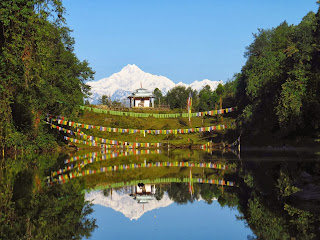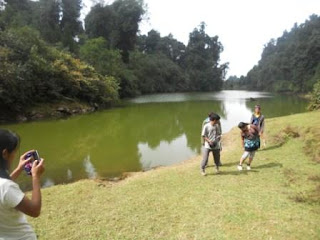Lingsey Mulkharka Lake is one Emerging Trekking destination
in Kalimpong District Commonly Known as
Chaya Tal (Reflected Kanchenjung in Lake). Since the promotional Period of Lingsey
Eco Tourism, Mulkharka Lake Trek getting Popularity in the Tourism industry.
On the occasion of Ram
Nawami every Year we celebrate the Festival as a symbol of Banabasi Life (Jungle Life) as well as
conduct Puja on the lake side. Treditional food & cultural show is the main
attractions of the festival.
On this occasion i.e 05/04/2017 (Ram Nawami) we Team Lingsey Eco tourism Organizing a Banabasi
Trail Tekking Programme from various Destinations, which will be finished on
05/04/2017 in Mulkharka Lake.
Various Trekking package we have made which are as Follows:
BANABASI TRAILS
Lingsey - Mulkharka Lake Trek
Pedong to
Mulkharka Lake
Duration: 5
Night 6 Days
Trek:
Moderate
Itinerary
Day-1: NJP to Pedong (90 Km) Stay Overnight
at Pedong.
Day-2:
After Breakfast Trekking Starts towards Kagey Village (12 km)
Day-3:
Early Morning Start from Kagey to Lingsey Via Rabang Khola. (10km)
Day-4:
Lingsey to Tagathang via Dhoksing Water Falls, Rock Garden (6km)
Day-5:
Tagathang to Mulkharka Village (5km)
Day-6:
Morning Kanchenjunga at Mulkharka Lake (1km) After Breakfast Transfer
to NJP.
BANABASI TRAILS
Lingsey - Mulkharka Lake Trek
Kolakham To
Mulkharka Lake:
Duration: 5
Night 6 Days
Trek:
Moderate
Day-1: NJP to Kolakham (120 Km) Stay Overnight
at Kolakham.
Day-2:
After Breakfast Trekking Starts towards Lunchu Village via Changey Waterfalls
(6 km)
Day-3:
Early Morning Start from Lungchu to
Changey Village Via Chun Khola (6 km)
Day-4:
Changey to Jhusing/Tagathang via Kholakharka (Birding Site) (7km)
Day-5:
Jhusing/Tagathang to Mulkharka Village
(3km)
Day-6: Morning
Kanchenjunga at Mulkharka Lake (1km) After Breakfast Transfer to NJP.
BANABASI TRAILS
Lingsey - Mulkharka Lake Trek
Lingsey To
Mulkharka Lake:
Duration: 4
Night 5 Days
Trek: Easy
Day-1: NJP to Lingsey
(116 Km) Stay Overnight at Lingsey.
Day-2: After Breakfast Trekking Starts towards Jhusing via
Dhoksing Waterfalls (3 km)
Day-3: Early Morning Start from Jhusing to Tagathang Village Via Rock Garden (3 km)
Day-4: Tagathang to Mulkharka via Ghaley Tar (4 km)
Day-5: Morning Kanchenjunga at Mulkharka Lake (1km) After
Breakfast Transfer
to NJP.
BANABASI TRAILS
Lingsey - Mulkharka Lake Trek
Lingsey to
Mulkharka Lake:
Duration: 3
Night 4 Days
Trek: Easy
Day-1: NJP to Lingsey
(116 Km) Stay Overnight at Lingsey.
Day-2: After Breakfast Trekking Starts towards Pithamchin (4
km)
Day-3: Early Morning Start from Pithamchin to Mulkharka Village via Chota Ramitey (5
km)
Day-4: Morning Kanchenjunga at Mulkharka Lake (1km) After
Breakfast Transfer.
to NJP.
BANABASI TRAILS
Lingseykha
to Mulkharka Lake:
Duration: 4Night 5 Days
Trek:
Moderate
Day-1: NJP to Lingseykha
(116 Km) Stay Overnight at Lingseykha.
Day-2: After Breakfast Trekking Starts towards Lingsey (6
km)
Day-3: Early Morning Start from Lingsey to Tagathang via Dokhsing Waterfalls (5 km)
Day-4: Tagathang to Mulkharka Village (4km)
Day-5: Morning Kanchenjunga at Mulkharka Lake (1km) After
Breakfast Transfer
to NJP.
BANABASI TRAILS
Lingsey - Mulkharka Lake Trek
Pithamchi To
Mulkharka Lake:
Duration: 2Night 3Days
Trek: Easy
Day-1: NJP to
Pithamchin, Stay overnight at Pithamchin. (120km)
Day-2: Pithamchin to Mulkharka Village (5km)
Day-3: Morning Kanchenjunga at Mulkharka Lake (1km) After
Breakfast Transfer
to NJP.
BANABASI TRAILS
Lingsey - Mulkharka Lake Trek
Tagathang
To Mulkharka Lake:
Duration: 2Night 3Days
Trek: Easy
Day-1: NJP to
Tagathang, Overnight at Tagathang. (125km)
Day-2: Tagathang to Mulkharka Village (4km)
Day-3: Morning Kanchenjunga at Mulkharka Lake (1km) After
Breakfast Transfer
to NJP.
BANABASI TRAILS
Lingsey - Mulkharka Lake Trek
Rishop to Mulkharka Lake
Duration: 5
Night 6 Days
Trek:
Moderate
Itinerary
Day-1: NJP to Rishop (110 Km) Stay Overnight
at Rishop.
Day-2:
After Breakfast Trekking Starts towards Lingseykha (Chuba) Village (12 km)
Day-3:
Early Morning Start from Lingseykha to Lingsey Via Rabang Khola. (6km)
Day-4:
Lingsey to Ghaley via Dhoksing Water Falls, Rock Garden (7km)
Day-5: Ghaley
to Mulkharka Village (2 km)
Day-6:
Morning Kanchenjunga at Mulkharka Lake (1km) After Breakfast Transfer
to NJP.












